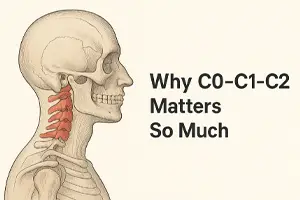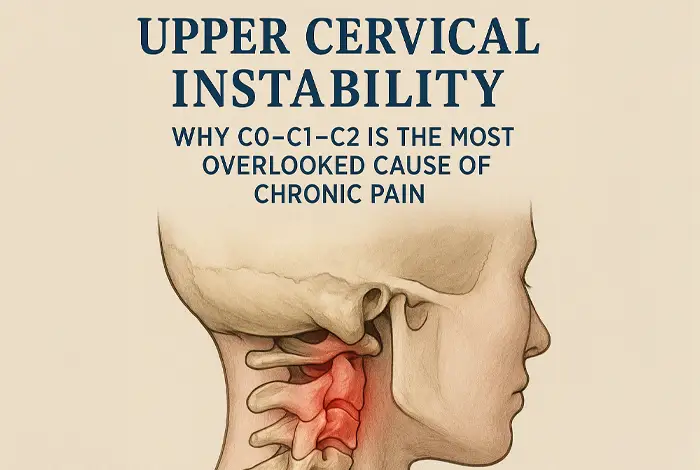You’ve had imaging. You’ve seen the specialists. You’ve even tried multiple treatments but the pain keeps coming back. Or worse… it never really went away.
If no one has investigated the upper cervical spine, especially the C0–C1–C2 complex, there may be a key piece of the puzzle missing:
Ligamentous instability at the base of the skull.
At DMX Miami, we specialize in diagnosing upper cervical instability using Digital Motion X-Ray (DMX) a dynamic, real-time imaging system that can detect what MRIs and CTs often miss.
Why C0–C1–C2 Matters So Much

The craniocervical junction (C0–C1–C2) is where:
- The base of the skull (occiput)
- The first vertebra (atlas / C1)
- The second vertebra (axis / C2)
all interact supporting the head and brainstem while enabling full range of motion.
This region contains:
- The brainstem
- Major blood flow pathways to the brain
- The vagus nerve and other cranial nerve connections
- Highly specialized ligaments (alar and transverse) for stability
Damage to these ligaments from trauma, whiplash, or even repetitive stress can lead to subtle but severe instability. And because this area is so neurologically rich, even small misalignments can produce life-altering symptoms.
Common Symptoms of C0–C1–C2 Instability
- Chronic headaches or head pressure
- Dizziness or lightheadedness
- “Heavy head” feeling, worse with movement
- Brain fog, fatigue, and poor concentration
- Visual disturbances or photophobia
- Neck tightness, cracking, or popping
- Sensory sensitivity or motion intolerance
These symptoms are often mistaken for:
- Migraines
- Post-concussion syndrome
- TMJ disorder
- Anxiety or chronic fatigue
- “Functional” disorders
But in many cases, the real issue is mechanical instability at the top of the spine.
How DMX Reveals What Others Miss
Digital Motion X-Ray (DMX) is the gold standard for detecting upper cervical instability. While traditional imaging shows your spine at rest, DMX captures it in motion recording 30 X-ray frames per second.
We guide you through gentle movements, watching for:
- Abnormal motion between C0–C1 and C1–C2
- Ligament laxity or failure
- Misalignment that only appears during motion
- Vertebral subluxation that correlates with symptoms
DMX visualizes your spine in real life not just on a static table.
Why This Region Gets Missed
Most radiologists and clinicians focus on the lower cervical spine (C4–C7) for disc herniations or arthritis.
But very few test the C0–C1–C2 region and almost no static imaging can capture instability there.
That’s why we see patients from around the world who have:
- Normal MRIs
- Unexplained chronic symptoms
- Worsening with head movement
- No clear diagnosis after months or years of testing
Patients Travel to DMX Miami From:
- Florida cities like Miami, Tampa, Fort Lauderdale, West Palm
- U.S. states including California, New York, Illinois, Texas
- Europe (UK, Germany, Spain, France)
- Latin America & the Caribbean (Colombia, Panama, Dominican Republic, Puerto Rico)
We offer:
- Bilingual staff (English/Spanish)
- Concierge scheduling for travel patients
- Reports and videos for your provider or legal case
- Coordination with regenerative and neurological specialists
Considering Regenerative Treatment?
Upper cervical instability often responds well to:
- Prolotherapy
- PRP (Platelet-Rich Plasma)
- Stem cell injections
- Targeted rehabilitation
DMX helps your doctor:
- Identify exact ligament damage
- Avoid misinjection or mistreatment
- Track progress post-treatment
Still Suffering Without a Diagnosis? Start Here.
If you feel like no one has found the root cause of your symptoms and nothing seems to help it’s time to look at the top of your spine.
Call 305-275-7475 or book your appointment online

Dr. Rodolfo Alfonso, D.C.
Dr. Mark N. Berry, D.C.
Sunset Chiropractic and Wellness
8585 Sunset Dr. STE 102
Miami, Florida 33143
305-275-7475
Schedule Your DMX Today
You’ve been searching for answers. Now you can see the cause of your symptoms in motion.
Visit us in Miami
Call 305-275-7475
Request an appointment online
Follow us on Instagram, Facebook, and YouTube for updates, patient success stories, and expert insights on neuropathy treatment!
